| Article ID | Journal | Published Year | Pages | File Type |
|---|---|---|---|---|
| 7051699 | Experimental Thermal and Fluid Science | 2018 | 22 Pages |
Abstract
A pulsating turbulent pipe flow has been investigated experimentally using hot-film anemometry and particle image velocimetry. Particularly, a 'paradoxical phenomenon' that is known to occur for a range of forcing frequencies and time-averaged Reynolds numbers has been investigated in detail. The paradoxical phenomenon is that the oscillating component of the wall shear stress exhibits a smaller amplitude in a turbulent flow compared to in a laminar flow exposed to the same oscillation in the pressure gradient. In here, the phenomenon is explained by splitting the response of the wall shear stress into one contribution resulting from the imposed pressure gradient Ïâ¼p, and a second contribution resulting from the oscillating Reynolds shear stress, Ïâ¼t. At the conditions of maximum reduction of the wall shear stress amplitude, Ïâ¼p and Ïâ¼t are nearly 136° out of phase. The contributions are thus interfering destructively, this being the ultimate reason for the reduced amplitude. It is also shown that the level of reduction is dependent on the imposed forcing amplitude, this in turn residing from a dependence of the time-development of the oscillating Reynolds shear stress on the forcing amplitude.
Related Topics
Physical Sciences and Engineering
Chemical Engineering
Fluid Flow and Transfer Processes
Authors
L.R. Joel Sundstrom, Michel J. Cervantes,
